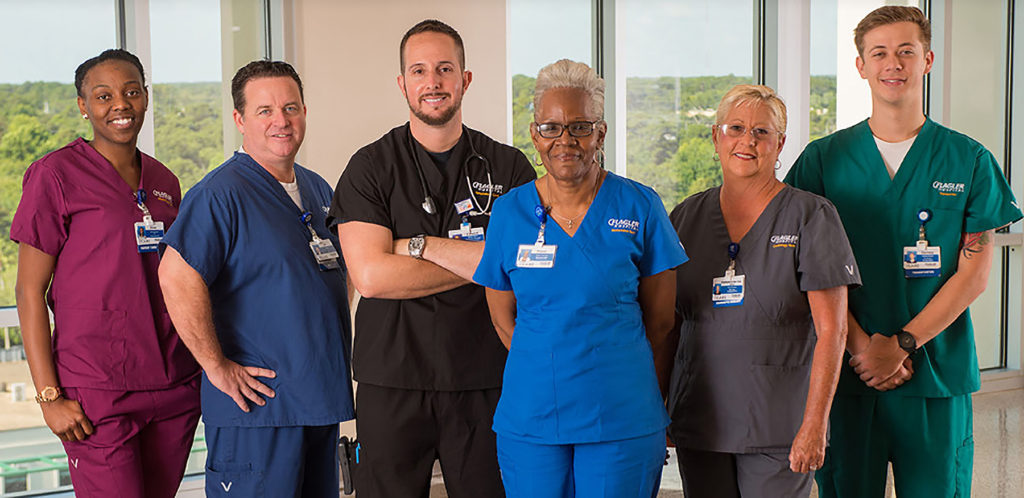
The DFW Hospital Council (DFWHC) is posting blogs submitted by our Associate Members. The following is the first of a series provided by Vestagen. For guidelines, please contact Chris Wilson at chrisw@dfwhc.org.
UNIFORMS – WHAT YOUR STAFF WEARS – are one of the most overlooked strategic opportunities for improvement on the Nurse Magnet, Quadruple Aim and High Reliability journey. With scrubs and lab coats, you must perfectly balance the desire for style and comfort, known to drive staff engagement, with patient satisfaction factors such as color preferences, employee role identification and communication. At the same time, you must re-enforce your culture of safety for both staff and patients. To help you achieve these critical initiatives when implementing your uniform program, we have developed a high impact, no or low cost and potentially profitable Donabedian Model. Our model is rooted in the Nurse Magnet Hospital Recognition Program and the principals of change management.
STRUCTURE
The first step is to gain commitment of a guiding coalition of leadership and staff that have urgency to take action based on the evidence. Transformational leadership is committed to evidence-based best practices that build your hospital brand, culture of safety, patient satisfaction and employee engagement. The urgency is driven by multiple studies documenting how apparel is part of protecting healthcare staff and patients; apparel color selection improves patient identification, communication and satisfaction; fit and comfort are all measurable. With an understanding of the evidence, informed decisions guide the Process leading to defined measurable Outcomes which can be developed and clear vision of how these key initiatives can be achieved. Once agreed upon, then clear and concise communication outlining the Process-outcomes is disseminated to staff.
PROCESS
Successfully executing implementation of a new uniform program begins with a well-defined process that has gone through multiple cycles of learning and has well-developed best practices. Having successfully executed implementations at some of the top health systems in the U.S., such as Northwell Health, Mercy Health, Baptist Health and HCA West Florida Division, we have developed proprietary best practices to quantitively and qualitatively evaluate the effectiveness, safety, comfort, fit, function, and durability of healthcare worker (HCW) attire. This part of the Process validates staff preferences and educates staff to make choices that support achieving the defined initiatives. The Process allows you and your staff to set clear roles and responsibilities, identify success criteria, and select implementation options that ensure your success.
The reported results of this Process provide actionable data addressing specific success criteria you established and a detailed roadmap with key insights from your staff that provide a clear path forward for a successful implementation. This structural engagement Process builds the desire, knowledge and ability of staff and is a vital “Win” for staff and leadership to have data that supports the implementation decision.
OUTCOMES
After being vetted by the proprietary due diligence process of the American Hospital Association (AHA) and conducting an in-depth analysis of the VESTEX market performance, track record and commitment to health care, VESTEX is the first and only apparel to earn the exclusive endorsement of the AHA.
Two case studies on successful Outcomes driven by this VESTEX implementation model have been documented by Baptist Health and Northwell Health’s Cohen Children’s Medical Center.
Baptist Health, Jacksonville, Florida, is a five-hospital system adopted VESTEX in 2014. Diane Raines, CNO, said they implemented VESTEX “as not just an investment in uniforms and patient garments, but as an innovative technology that will make our environment safer. This (VESTEX) is a symbol of our commitment to our staff and their families and our patients and their families.”
The hospital had also launched a new branding campaign, “Changing Healthcare for Good” and wanted to increase community brand awareness for the health system. In support of the new campaign, Baptist Health received eight strongly positive local television stories and 51 print media stories related to their VESTEX implementation.
Cohen Children’s Medical Center, Long Island, New York, was the first of the 23 Hospital Northwell Health System to wholly adopt VESTEX. The nursing team was working toward attaining Magnet recognition. They were also finding that patients and their families were struggling with identifying the difference between nurses, nursing assistants, physicians, housekeepers, practice care assistants and other care providers by their roles. Additionally, the health system had recently changed its name, so the hospital wanted to reflect that change in its entire care team’s uniforms.
The VESTEX implementation model resulted in 93 percent of Cohen staff agreeing that VESTEX should be adopted as part of their daily work attire. Cohen staff engagement scores improved from the 72nd to the 87th percentile, while participation rates increased across disciplines from 81 to 95 percent. “Engagement in the product selection and overall engagement in the organization’s safety work, led to this positive trend in our scores,” said Carri Quinn, CNO. The Northwell Health System continues to receive local television and print coverage with each new VESTEX implementation.
What you wear matters! Achieving success in key strategic initiative Outcomes are attained by finding the balance between desires and preferences of hospital staff and patient. Our Structure – Process – Outcome model provides a clear path forward rooted in well-established best practices, scientific principals and published medical literature.
Vestagen – Hospital uniforms are a great opportunity for improvement
11/30/2017